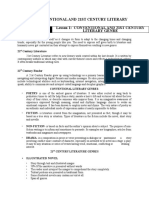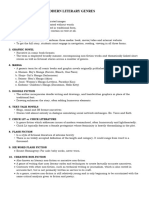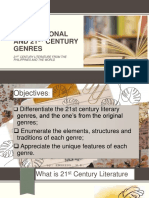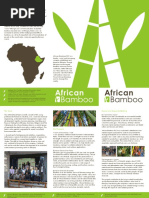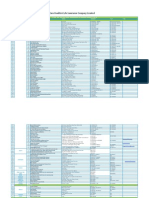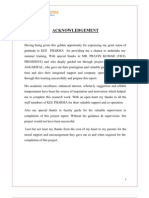0 ratings0% found this document useful (0 votes)
23 views21st Century Lit Genres
21st Century Lit Genres
Uploaded by
agcaoilijhon06Copyright:
© All Rights Reserved
Available Formats
Download as PPTX, PDF, TXT or read online from Scribd
21st Century Lit Genres
21st Century Lit Genres
Uploaded by
agcaoilijhon060 ratings0% found this document useful (0 votes)
23 views25 pagesCopyright
© © All Rights Reserved
Available Formats
PPTX, PDF, TXT or read online from Scribd
Share this document
Did you find this document useful?
Is this content inappropriate?
Copyright:
© All Rights Reserved
Available Formats
Download as PPTX, PDF, TXT or read online from Scribd
Download as pptx, pdf, or txt
0 ratings0% found this document useful (0 votes)
23 views25 pages21st Century Lit Genres
21st Century Lit Genres
Uploaded by
agcaoilijhon06Copyright:
© All Rights Reserved
Available Formats
Download as PPTX, PDF, TXT or read online from Scribd
Download as pptx, pdf, or txt
You are on page 1of 25
Conventional and 21st
Century Genres
MARY KAY D. MENOR
Teacher II
After going through this lesson, you are expected to:
• 1. differentiate the 21st century literary genres, and the
one’s from the original genres;
• 2. enumerate the elements, structures and traditions of
each genre;
• 3. appreciate the unique features of each genre.
21st Century Literature
21st Century Literature refers to new literary work
created within the last decade. It is written by
contemporary authors which may deal with current
themes/ issues and reflects a technological
culture. It often breaks traditional writing rules.
21st Century Reader
A 21st Century Reader grew up using technology as a
primary learning tool.
He is capable of navigating and interpreting digital formats and
media messages.
He also possesses literacy skills, which include technological
abilities such as keyboarding, internet navigation, interpretation
of technological speak, ability to communicate and interpret
coded language and decipher graphics.
ILLUSTRATED NOVEL
• Story through text and illustrated images
• 50% of the narrative is presented without words
• The reader must interpret the images to comprehend the story completely.
• Textual portions are presented in traditional form.
• Some illustrated novels may contain no text at all.
• Span all genres.
• Examples include The Invention of Hugo Cabret by Brian Selznick and
The Arrival by Shaun Tan.
ILLUSTRATED NOVEL
DIGI FICTION
• Triple Media Literature
• Combines three media: book, movie/video and internet website
• To get the full story, students must engage in navigation,
reading, and viewing in all three forms.
• Patrick Carman’s Skeleton Creek and Anthony Zuiker’s Level
26 are examples.
GRAPHIC NOVEL
• Narrative in comic book formats
• Narrative work in which the story is conveyed to the reader using a comic
form.
• The term is employed in broadly manner, encompassing non-fiction
works and thematically linked short stories as well as fictional stories
across a number of genres.
• Archie Comics by John Goldwater and illustrator, Bob Montana, is a
good example.
MANGA
• Japanese word for comics
• It is used in the English-speaking world as a generic term for
all comic books and graphic novels originally published in
Japan.
• Considered as an artistic and storytelling style.
• Ameri-manga- sometimes used to refer to comics created by
American artists in manga style.
MANGA
• Shonen- Boy’s Manga (Naruto, Bleach, One Piece)
• Shojo- Girl’s Manga (Sailormoon)
• Seinen- Men’s Manga (Akira)
• Josei- Women’s Manga (Loveless, Paradise Kiss)
• Kodomo- Children’s Manga (Doraemon, Hello Kitty)
DOODLE FICTION
• Literary presentation where the author incorporates doodle
writing, drawings and handwritten graphics in place of the
traditional font.
• Drawing enhances the story, often adding humorous elements
• Examples include The Diary of a Wimpy Kid by Jeff Kinney
and Timmy Failure by Stephan Pastis.
TEXT-TALK NOVEL
• Blogs, email and IM format narratives
• Stories told almost entirely in dialogue simulating
social network exchanges.
CHICK LIT or CHICK
LITERATURE
• Is genre fiction which addresses issues of modern womanhood,
often humorously and lightheartedly.
• • Chick Lit typically features a female protagonist whose
femininity is heavily thermalizing in the plot.
• • Scarlet Bailey’s The night before Christmas and Miranda
Dickinson’s It started with a Kiss are examples of this.
FLASH FICTION
• Is a style of fictional literature of extreme brevity
• There is no widely accepted definition of the length
and category. It could range from word to a thousand.
SIX-WORD FLASH FICTION
• Ernest Hemingway: For sale: baby socks, never worn.
• Margaret Atwood: Longed for him. Got him, Shit.
CREATIVE NONFICTION
• Also known as literary non-fiction or narrative non-fiction
• A genre of writing that uses literary styles and techniques to
create factually accurate narratives.
• Contrasts with other non-fiction, such as technical writing or
journalism, which is also rooted in accurate fact, but is not
primarily written in service to its craft.
.
CREATIVE NONFICTION
• As a genre, creative non-fiction is still relatively young and is
only beginning to be scrutinized with the same critical analysis
given to fiction and poetry.
• 1000 Gifts by Ann Voscamp and Wind, Sand, and Stars by
Antoine de Saint-Exupery are examples.
SCIENCE FICTION
• Is a genre of speculative fiction dealing with imaginative concepts such as
futuristic science and technology, space travel, time travel, faster than
light travel, a parallel universe and extra-terrestrial life.
• Often explores the potential consequences of scientific and other
innovations and has been called a “literature of ideas”.
• Examples include Suzanne Collins’ Mockingjay and Sarah Maas’
Kingdom of Ash.
BLOG
• A weblog, a website containing short articles called
posts that are changed regularly.
• • Some blogs are written by one person containing his
or her own opinions, interests and experiences, while
others are written by different people.
HYPER POETRY
• • Digital poetry that uses links and hypertext mark-up
• • It can either involved set words, phrases, lines, etc. that are presented in
variable order but sit on the page much as traditional poetry does, or it can
contain parts of the poem that move and transform.
• • It is usually found online, through CD-ROM and diskette versions exist. The
earliest examples date to no later than the mid-1980’s.
You might also like
- 21ST Century Lit GenresDocument4 pages21ST Century Lit GenresAi SafiraNo ratings yet
- Lesson 4Document17 pagesLesson 4Lily Mae De ChavezNo ratings yet
- 21st Century Literary GenresDocument1 page21st Century Literary GenresMaria Teresa AyoNo ratings yet
- Conventional AND 21St Century GenresDocument34 pagesConventional AND 21St Century GenresMyrna NicolasNo ratings yet
- 21st Century Lit. Module 4 - 083350Document33 pages21st Century Lit. Module 4 - 083350Kamverly MangayaNo ratings yet
- 21st Century - Lit GenresDocument37 pages21st Century - Lit Genresmenmic749No ratings yet
- Lesson 3 21st Century LiteratureDocument33 pagesLesson 3 21st Century Literaturegonzalesjayc325No ratings yet
- 21st Century Lit Lesson 3 ModuleDocument4 pages21st Century Lit Lesson 3 ModuleFahad M. AbdullahNo ratings yet
- 21st WEEK 3 GENRES 1Document36 pages21st WEEK 3 GENRES 1nickzapanta45No ratings yet
- 21st Century Module 2Document9 pages21st Century Module 2Janlester DiazNo ratings yet
- 21st Lesson 3 The Various 21st Century Literary Genres and The Ones From The Earlier GenresDocument3 pages21st Lesson 3 The Various 21st Century Literary Genres and The Ones From The Earlier GenreslukeruizticarNo ratings yet
- GENRESDocument2 pagesGENRESjoyvelyn.ramilNo ratings yet
- 21ST cENTURY LIT GENRES HANDOUTDocument3 pages21ST cENTURY LIT GENRES HANDOUTAi SafiraNo ratings yet
- Q1 Module 3Document4 pagesQ1 Module 3Clare SiplonNo ratings yet
- Module 2 The Major Literary GenresDocument2 pagesModule 2 The Major Literary GenresRuth Kristel SantosNo ratings yet
- Module - 2Document25 pagesModule - 2Prosavage KillerXXNo ratings yet
- 21st CENTURY LITERARY GENRESDocument33 pages21st CENTURY LITERARY GENRESGwyneth Morales PagunsanNo ratings yet
- 21st Conventional and 21st Century Genres Week 3 PDFDocument25 pages21st Conventional and 21st Century Genres Week 3 PDFStephanie Nichole Ian CasemNo ratings yet
- 21st Century Literature Ppt2Document20 pages21st Century Literature Ppt2Lloyd Gabriel PoligratesNo ratings yet
- 21st Century Q3 Week 5Document74 pages21st Century Q3 Week 5Philiprie CachoNo ratings yet
- 21stcenturyliterarygenrefinal 180525103420 PDFDocument43 pages21stcenturyliterarygenrefinal 180525103420 PDFNicole Celoso AtizardoNo ratings yet
- 21St Century Literature Genre: Miss Paulene Galimba GacusanDocument43 pages21St Century Literature Genre: Miss Paulene Galimba GacusanKarla Bernadette Honrado100% (2)
- Q3-Lesson 3 - 21st Century Literary GenresDocument36 pagesQ3-Lesson 3 - 21st Century Literary GenresJoanne Roanne FelicianoNo ratings yet
- 21st Century LiteratureDocument36 pages21st Century Literatureroseblood0000No ratings yet
- 21st Century Lit Module 2 StudentsDocument49 pages21st Century Lit Module 2 Studentscamerogabriel5No ratings yet
- 21 ST ReportDocument17 pages21 ST Reportdanaoralph66No ratings yet
- Define What Literary Genre IsDocument37 pagesDefine What Literary Genre IsJuen Dave Geonzon BalumaNo ratings yet
- 21st Literary GENRE1Document17 pages21st Literary GENRE1QUEENIE DINAPONo ratings yet
- 21st Century Literature GenresDocument19 pages21st Century Literature GenresSabel Ross CaliliwNo ratings yet
- 21st Century Literary GenreDocument47 pages21st Century Literary GenreJoan UrmanitaNo ratings yet
- Lesson 4 21st Century GenresDocument25 pagesLesson 4 21st Century Genresjohnlesther de veraNo ratings yet
- Topic: 21St Century Literary GenresDocument2 pagesTopic: 21St Century Literary GenresMeiss Ly90% (10)
- 21st Century Literature GenresDocument32 pages21st Century Literature GenresAnything AnythingNo ratings yet
- Lesson 3. Conventinal and 21st Century Literature GenresDocument36 pagesLesson 3. Conventinal and 21st Century Literature Genresraizelpadlan06No ratings yet
- 21ST CenturyDocument67 pages21ST Centurykrislyn marie layosNo ratings yet
- 21st Century Literaty GenreDocument23 pages21st Century Literaty GenreJustine Lei dela CruzNo ratings yet
- 21st Century Literary GenresDocument1 page21st Century Literary GenresJenny Love Besavilla100% (1)
- GenreDocument46 pagesGenreKayley Keisha BarriosNo ratings yet
- Literary Genres Module 2Document17 pagesLiterary Genres Module 2auxillokeishaNo ratings yet
- 21 Century Literature From The Philippines and The WorldDocument37 pages21 Century Literature From The Philippines and The WorldMrGoNo ratings yet
- 21st Century Literature - Lesson 2Document46 pages21st Century Literature - Lesson 2Pau DelrosarioNo ratings yet
- Lit Week 2Document50 pagesLit Week 2Alejandro SantosNo ratings yet
- 21st Century Literature Genres 1Document19 pages21st Century Literature Genres 1Charice RamosNo ratings yet
- LESSON 6 21st Century Literature Genres 2Document24 pagesLESSON 6 21st Century Literature Genres 2Kian BonaobraNo ratings yet
- 21st Century Literary Genres SCDocument22 pages21st Century Literary Genres SCsweetestwine18No ratings yet
- 21st Century Literary Genres, Elements, and StructuresDocument20 pages21st Century Literary Genres, Elements, and StructuresJrick Escobar100% (2)
- 21st Century Literary GenresDocument24 pages21st Century Literary GenresAssej AidialNo ratings yet
- 21st Cent Lit 11 LK 1 Lesson 3Document15 pages21st Cent Lit 11 LK 1 Lesson 3Rea JadeNo ratings yet
- 21ST Century (Periodicals)Document12 pages21ST Century (Periodicals)Batnoy FransyyyNo ratings yet
- 21st Century q3w2 HandoutDocument2 pages21st Century q3w2 Handoutbq5zfmk85dNo ratings yet
- 4 21st Century Literary GenresDocument45 pages4 21st Century Literary Genreskashillegutierrez10No ratings yet
- Literary GenresDocument56 pagesLiterary GenresOtencianoNo ratings yet
- Different Periods of Philippine LiteratureDocument79 pagesDifferent Periods of Philippine LiteratureAdelle ChuaNo ratings yet
- 21st Literarygenres DDDocument65 pages21st Literarygenres DDMatthew Brian UbacNo ratings yet
- Teaching-Guide - 3Document7 pagesTeaching-Guide - 3maepaule06No ratings yet
- 21st Century Literary GenresDocument30 pages21st Century Literary GenresJohn Roldan Almendras PuraNo ratings yet
- q2 English 10 Lesson 3Document53 pagesq2 English 10 Lesson 3Ana Karina AbanteNo ratings yet
- 3RD Week in Socsci 101Document7 pages3RD Week in Socsci 101Marlon AndayaNo ratings yet
- Conventional and 21st Century Literary GenresDocument44 pagesConventional and 21st Century Literary Genreskimberlynicoleabainza97No ratings yet
- Marvel Comics in the 1970s: The World inside Your HeadFrom EverandMarvel Comics in the 1970s: The World inside Your HeadRating: 4 out of 5 stars4/5 (2)
- A Reflection of The Life Changing Experience in My LifeDocument2 pagesA Reflection of The Life Changing Experience in My LifeEricka Rivera SantosNo ratings yet
- Edexcel A Level English Literature Coursework ExamplesDocument5 pagesEdexcel A Level English Literature Coursework Examplesafazamfbk100% (1)
- Lecture 04-Seismic Provisions Based On NSCPDocument35 pagesLecture 04-Seismic Provisions Based On NSCPRA CruzNo ratings yet
- Interlinear JudeDocument9 pagesInterlinear Judenapash creationNo ratings yet
- Cases - To DigestDocument358 pagesCases - To DigestApril Charm ObialNo ratings yet
- Resume TemplateDocument2 pagesResume Templateapi-407859718No ratings yet
- AB Brochure 20121112Document2 pagesAB Brochure 20121112Daniel PinheiroNo ratings yet
- Gender Religion and Caste Chapter 4 (Repaired)Document4 pagesGender Religion and Caste Chapter 4 (Repaired)army goodwill school wuzur qazigundNo ratings yet
- Capstone Final ReportDocument28 pagesCapstone Final Reportapi-557289650No ratings yet
- Automation of Belt Conveyor SystemDocument11 pagesAutomation of Belt Conveyor SystemSummA Learning CenterNo ratings yet
- Anh ngữ ITD - Luyện thi vào lớp 6, chuyên Anh, Đại học Hotline: 024 7306 2622Document52 pagesAnh ngữ ITD - Luyện thi vào lớp 6, chuyên Anh, Đại học Hotline: 024 7306 2622Quang Anh NguyễnNo ratings yet
- Area of Research InterestDocument5 pagesArea of Research InterestMandeep Singh RanaNo ratings yet
- Zenith Interface Unit - Setup and Configuration Manual (For Use With Zenith Choke Assembly)Document51 pagesZenith Interface Unit - Setup and Configuration Manual (For Use With Zenith Choke Assembly)Noelia Janet GutierrezNo ratings yet
- Asia Care Network HospitalsDocument4 pagesAsia Care Network HospitalsChan Mehboob50% (2)
- At The AirportDocument2 pagesAt The Airportlakmus6No ratings yet
- Summer Training Report AbhiDocument51 pagesSummer Training Report AbhiAbhijit MohantyNo ratings yet
- AIIMS PG Entrance May 2004 Solved Question Paper With KeyDocument15 pagesAIIMS PG Entrance May 2004 Solved Question Paper With KeySAIFNo ratings yet
- NRL NRL NRL NRL: Request For QuotationDocument23 pagesNRL NRL NRL NRL: Request For QuotationIrwan KmNo ratings yet
- Ichimoku Kinko Hyo Trading Explained - PDF Download: Japanese ChartingDocument13 pagesIchimoku Kinko Hyo Trading Explained - PDF Download: Japanese ChartingEko Aji WahyudinNo ratings yet
- PlumbingDocument1 pagePlumbingminesdomieNo ratings yet
- Thole CompanyProfileDocument8 pagesThole CompanyProfileThabo KhuluseNo ratings yet
- Usain Bolt BiographyDocument1 pageUsain Bolt Biographyamritkathuria95176No ratings yet
- Mini CE Board SimulationDocument17 pagesMini CE Board SimulationRamjie JoveroNo ratings yet
- UnpublishedDocument10 pagesUnpublishedScribd Government DocsNo ratings yet
- WPH06 01 Que 20190128daDocument20 pagesWPH06 01 Que 20190128daHamza Tahir IqbalNo ratings yet
- IC Engines4Document10 pagesIC Engines4GovindNo ratings yet
- Sandra J. Judd - Eating Disorders Sourcebook (2010, Omnigraphics Inc) PDFDocument605 pagesSandra J. Judd - Eating Disorders Sourcebook (2010, Omnigraphics Inc) PDFCualit14100% (1)
- Equity and Education: December 2015Document8 pagesEquity and Education: December 2015SarahLNo ratings yet
- Alternators Alternators LSA 37.2 - Single Phase - 4 Pole LSA 37.2 - Single Phase - 4 PoleDocument6 pagesAlternators Alternators LSA 37.2 - Single Phase - 4 Pole LSA 37.2 - Single Phase - 4 PoleEMS CommerceNo ratings yet
- Bloan CalculatorDocument8 pagesBloan CalculatorLEE KAR WEINo ratings yet









